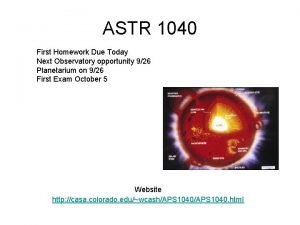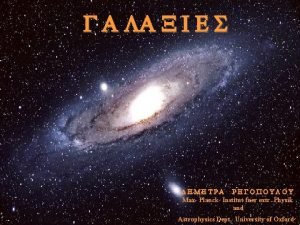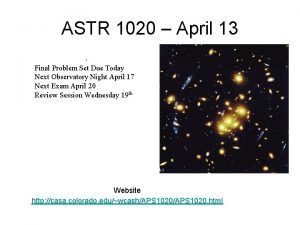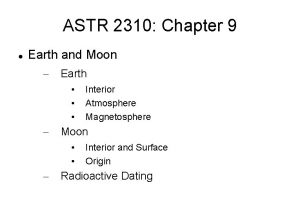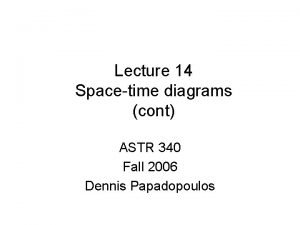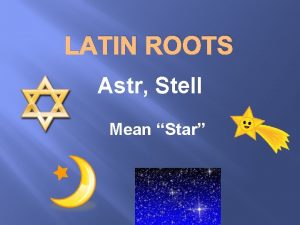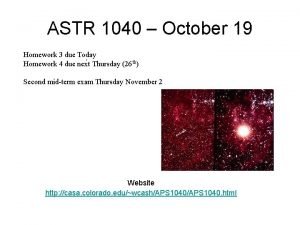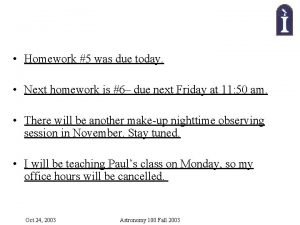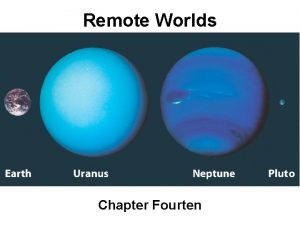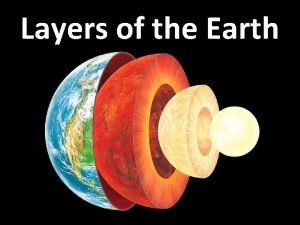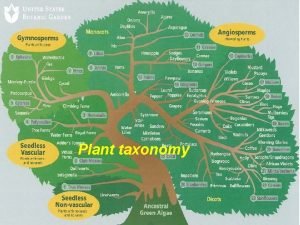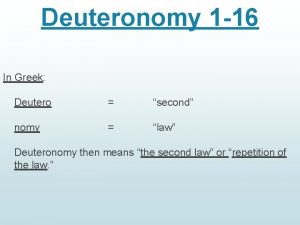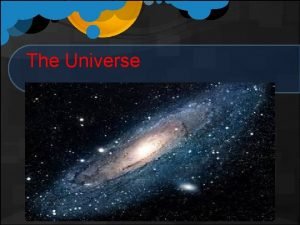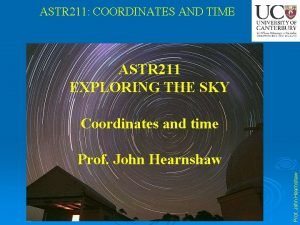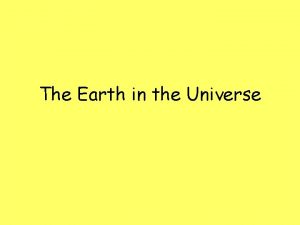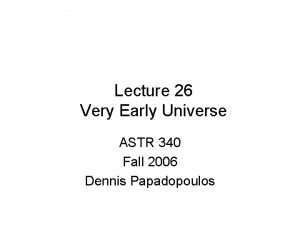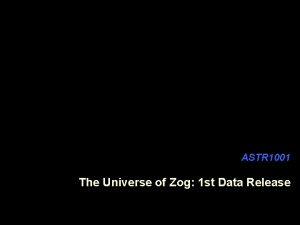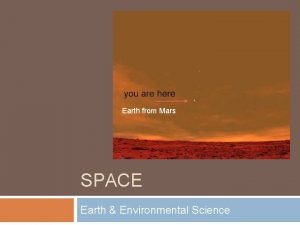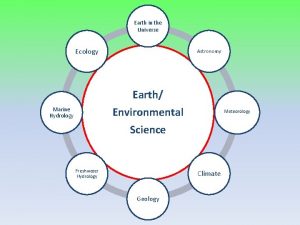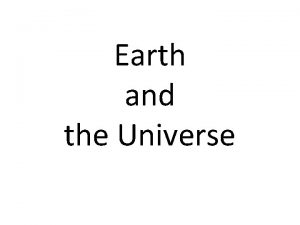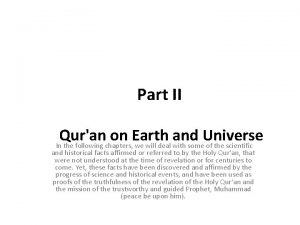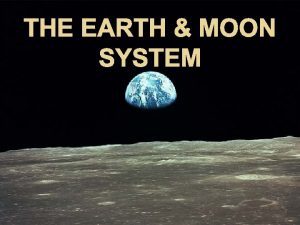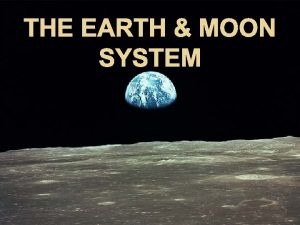Astr nomy Part 1 Earth in the Universe



























































- Slides: 59

Astr nomy Part 1 – Earth in the Universe

The Big Bang Video

• The universe started with a concentrated area of matter and energy. • 15 -20 billion years ago. • Then, it exploded and has been expanding ever since.

• Matter began to clump together forming stars and galaxies. • The universe continued to expand is still expanding today.

Our Expanding Universe Video

Regents Question Which celestial feature is largest in actual size? (1) the Moon (2) the Sun (3) Jupiter (4) the Milky Way Answer is… 4

• How do we know the universe is expanding? • Pg. 14 in the ESRT shows the electromagnetic spectrum. • Notice that in the visible spectrum there all the colors of the rainbow.


Please answer the questions on the Electromagnetic spectrum ½ sheet.

• When looking at the visible spectrum wavelengths are shifted either to the blue end (shorter wave) or the red end (longer wave). • This shift in wavelengths is called the Doppler Effect. • If they are shifted towards red, they are moving away from you. • If they are shifted toward blue, they are coming towards you.

• When scientists look at the universe, they see a red shift. This proves it is moving away from us, thus, expanding!

A Quick look at the Doppler Affect Using a police car

Another look at the Doppler Affect using sound

Earth Science Light from galaxies moving away Rocks Notice the shift towards red

Earth Science Light from galaxies moving toward us Rocks Notice the shift towards blue.


• A galaxy is a collection of billions of stars and gas and dust. • Our solar system is part of the Milky Way Galaxy. • The Milky Way is a spiral-shaped galaxy.



Regents Question The Milky Way Galaxy is best described as (1) elliptical (2) circular (3) irregular (4) Spiral Answer is… 4


Earth Science Rock • A star is usually a large ball of gas held together by gravity. • Energy is produced by nuclear fusion – combination of nuclei of smaller elements to form nuclei of larger elements.

Regents Question Which star color indicates the hottest star surface temperature? (1) blue (2) yellow (3) white (4) Red

The good news!! This is all for free on pg. 15 of the ESRT!

Regents Question Which star color indicates the hottest star surface temperature? (1) blue (2) yellow (3) white (4) Red Answer is… 1

Regents Question In the main sequence, compared to the surface temperature and luminosity of massive stars, the smaller stars are (1) hotter and less luminous (2) hotter and more luminous (3) cooler and less luminous (4) cooler and more luminous Answer is… 3

Life and Death of a Star Video Clip

Take out ESRT- Page 15

1. What is the most massive star on the chart? DENEB ________________ 2. What is the temperature and luminosity 5, 600 ºK of the Sun? _________ and Luminosity = 1 ________ 3. What group is a star in during a late stage? White Dwarfs ________________

Page 15

4. What is the temperature and luminosity of 3300ºK Betelguese? __________ and 200, 000 __________ 5. What color would a star be if it was 15, 000ºK? Blue White ________________ 6. What group of star is Albebaran in? Giants ________________

Page 15

7. What temperature and color is Proxima Centauri? 2800ºK Red _________ and _________ 8. Massive stars are (more / less) luminous. (Circle one) Procyon B or Eridani B 9. Name a White Dwarf star. _________ 10. What stage are Main Sequence stars in? _______ Early

• The solar system is the sun and all objects that orbit the sun under its gravitational influence. • Our solar system has 1 sun and 8 planets.


Regents Question The Sun’s position in space is best described as the approximate center of (1) a constellation (2) the universe (3) the Milky Way galaxy (4) our solar system Answer is… 4

Regents Question Compared to Earth’s solar system, the universe is inferred to be (1) younger and larger (2) older and larger (3) younger and smaller (4) older and smaller Answer is… 2

Pluto? New Chart in your ESRT… Sorry Pluto…

Using the data table on page 15 of your ESRT, answer the following questions. 1. What is the period of rotation of Mercury? _______________ 59 d 2. What is a year on Mars? _____________________ 687 d 3. Which planet has the most eccentric orbit? ______________ Mercury 4. Which has the least eccentric orbit? ______________ Venus 5. What is the diameter of Jupiter? _____________ 142, 984 km 6. What is a day on Saturn? _____________________ 10 h 14 min

Venus Jupiter 7. Which planet has the longest period of rotation? _____The shortest? _____ Earth Saturn 8. Which planet is the most dense? _______The least? ______ 108. 2 million km 9. How far from the sun is Venus? _________ 0. 386 million km 10. How far from Earth is our Moon? ___________________ 4, 498. 3 million km 11. What is the mass of Neptune ? __________ 60, 268 km 12. What is the radius of Saturn? ________________

Regents Question Which event takes the most time? (1) one revolution of Earth around the Sun (2) one revolution of Venus around the Sun (3) one rotation of the Moon on its axis (4) one rotation of Venus on its axis Answer is… 1

• An ellipse is an oval shape. • Earth’s orbit around the sun is an ellipse. • Within an ellipse, there are two fixed points called foci. • In our solar system, the sun is ALWAYS ONE of those foci.

• The degree of flatness or “ovalness” of an ellipse is measured by eccentricity. • This formula is on page 1 of your ESRT!

• The more oval the orbit is, the more eccentric it is, or the higher the eccentricity. Increasing Eccentricity


• Calculating Eccentricity: Major Axis X Foci 1 X Foci 2

An ellipse is an example of a “conic section”. Circles and hyperbolas are others. All are possible forms for orbits. You can make an ellipse with 2 tacks and a string. The tacks are the “foci”, and if you put them further apart, the ellipse is more “eccentric” (one tack makes a circle).

• Calculating Eccentricity: • When you measure those 2 distances and calculate them, you will NEVER get higher than 1!! • The closer to 1 you are the MORE oval or eccentric the orbit. • The closer to 0 you are the LESS oval or eccentric the orbit.

Regents Question Which planet’s orbit around the Sun is most nearly circular? (ESRT 15) (1) Mercury (2) Pluto (3) Neptune (4) Venus Answer is… 4 No More Pluto

• The closer 2 objects are to each other, the greater the gravitational pull between them. • Therefore, during the perihelion – when Earth is closer to the sun, there is a greater gravitational pull between it and the sun. • This makes the Earth speed up a bit in its orbit around the sun during that time.

Earth Science Rocks Perihelion Aphelion

Planets move What do you noticequicker about the planets orbital velocity? the closer they are to the Sun Aphelion Perihelion

Kepler’s Second Law

Regents Question Compared to Neptune, Mercury moves more rapidly in its orbit because Mercury (1) is larger (2) is more dense (3) is closer to the Sun (4) has a more elliptical orbit Answer is… 3

Distance between foci length of Major Axis X X Write the formula for eccentricity below: Page 1 of ESRT’s Calculate the eccentricity of the ellipse. 6. 4 cm Distance between foci: _______ 8. 8 cm Length of major axis: _______. 72 Eccentricity= _______

Distance between foci Length of Major Axis X X Calculate the eccentricity of the ellipse. 1. 3 cm Distance between foci: _______ 5. 4 cm Length of major axis: _______. 24 Eccentricity= _______

What is the minimum value that eccentricity 0 can be? ____ The more eccentric Doesn’t a circle look the more stretched like a zero? ? out until you get a straight line What is the maximum value that. 99 eccentricity can be? _______ Look the # one.


 Astr
Astr Bracione
Bracione 5-a-day language review week 9 answer key
5-a-day language review week 9 answer key Quasar spectrum
Quasar spectrum Astr
Astr Twin paradox
Twin paradox Astr greek or latin
Astr greek or latin Astr
Astr That was due today
That was due today Trans neptunian objects
Trans neptunian objects Heat flowing out of earth as it cools
Heat flowing out of earth as it cools Oceanic crust
Oceanic crust The strong lower part of the mantle
The strong lower part of the mantle 3 layers of the earth
3 layers of the earth Part of the earth
Part of the earth Part d earth science regents
Part d earth science regents Một số thể thơ truyền thống
Một số thể thơ truyền thống Thế nào là hệ số cao nhất
Thế nào là hệ số cao nhất Lp html
Lp html Sơ đồ cơ thể người
Sơ đồ cơ thể người Các số nguyên tố
Các số nguyên tố đặc điểm cơ thể của người tối cổ
đặc điểm cơ thể của người tối cổ Cách giải mật thư tọa độ
Cách giải mật thư tọa độ Các châu lục và đại dương trên thế giới
Các châu lục và đại dương trên thế giới Thang điểm glasgow
Thang điểm glasgow ưu thế lai là gì
ưu thế lai là gì Thẻ vin
Thẻ vin Tư thế ngồi viết
Tư thế ngồi viết Cái miệng bé xinh thế chỉ nói điều hay thôi
Cái miệng bé xinh thế chỉ nói điều hay thôi Các châu lục và đại dương trên thế giới
Các châu lục và đại dương trên thế giới Bổ thể
Bổ thể Từ ngữ thể hiện lòng nhân hậu
Từ ngữ thể hiện lòng nhân hậu Tư thế ngồi viết
Tư thế ngồi viết V cc
V cc Phép trừ bù
Phép trừ bù Thể thơ truyền thống
Thể thơ truyền thống Chúa yêu trần thế alleluia
Chúa yêu trần thế alleluia Hươu thường đẻ mỗi lứa mấy con
Hươu thường đẻ mỗi lứa mấy con đại từ thay thế
đại từ thay thế Diễn thế sinh thái là
Diễn thế sinh thái là Vẽ hình chiếu vuông góc của vật thể sau
Vẽ hình chiếu vuông góc của vật thể sau Công của trọng lực
Công của trọng lực Thế nào là mạng điện lắp đặt kiểu nổi
Thế nào là mạng điện lắp đặt kiểu nổi Tỉ lệ cơ thể trẻ em
Tỉ lệ cơ thể trẻ em Lời thề hippocrates
Lời thề hippocrates Vẽ hình chiếu đứng bằng cạnh của vật thể
Vẽ hình chiếu đứng bằng cạnh của vật thể Quá trình desamine hóa có thể tạo ra
Quá trình desamine hóa có thể tạo ra Các môn thể thao bắt đầu bằng tiếng nhảy
Các môn thể thao bắt đầu bằng tiếng nhảy Hát kết hợp bộ gõ cơ thể
Hát kết hợp bộ gõ cơ thể Sự nuôi và dạy con của hổ
Sự nuôi và dạy con của hổ điện thế nghỉ
điện thế nghỉ Các loại đột biến cấu trúc nhiễm sắc thể
Các loại đột biến cấu trúc nhiễm sắc thể Biện pháp chống mỏi cơ
Biện pháp chống mỏi cơ Phản ứng thế ankan
Phản ứng thế ankan Trời xanh đây là của chúng ta thể thơ
Trời xanh đây là của chúng ta thể thơ Gấu đi như thế nào
Gấu đi như thế nào Thiếu nhi thế giới liên hoan
Thiếu nhi thế giới liên hoan Vẽ hình chiếu vuông góc của vật thể sau
Vẽ hình chiếu vuông góc của vật thể sau Unit ratio definition
Unit ratio definition Under bar function
Under bar function
